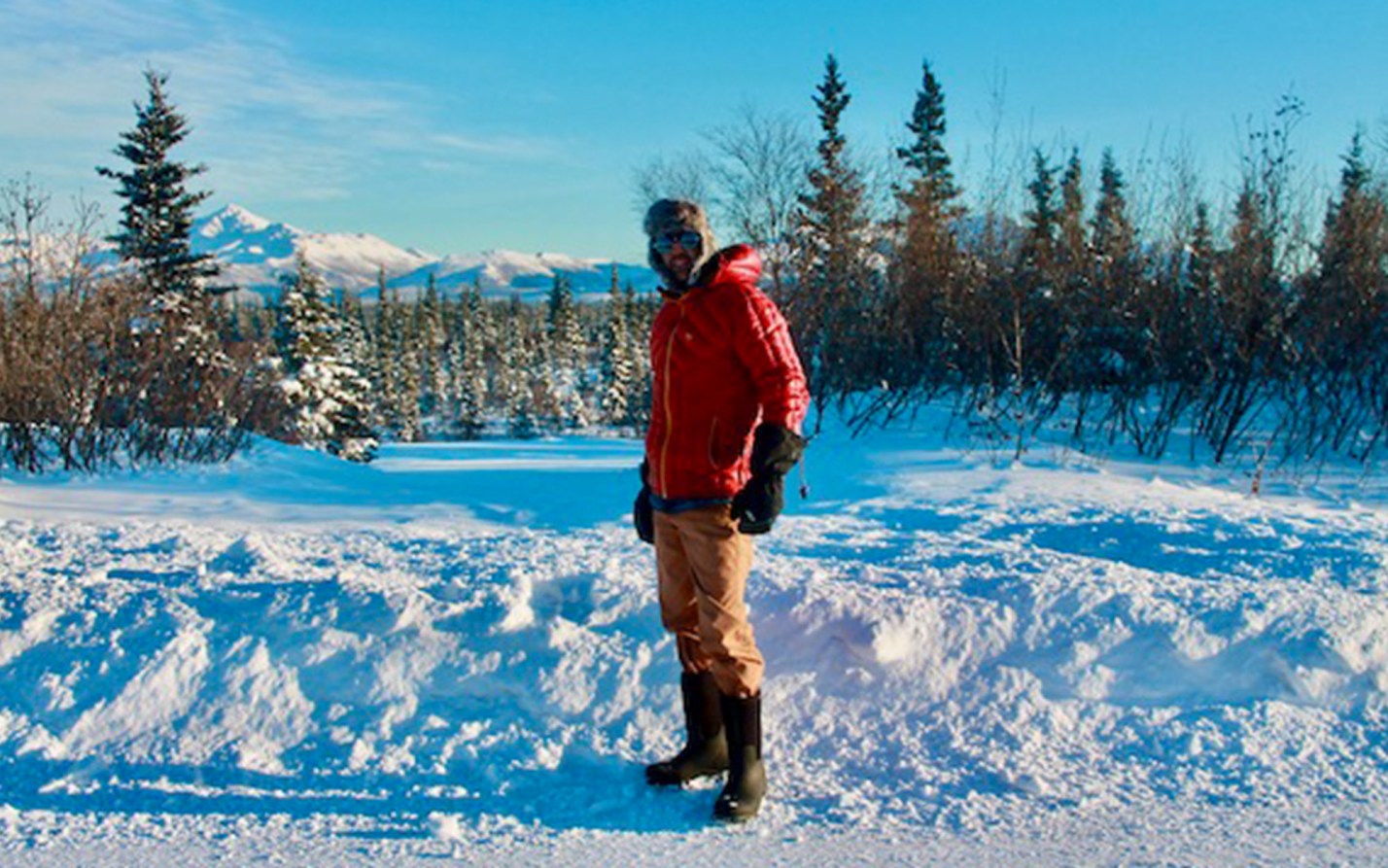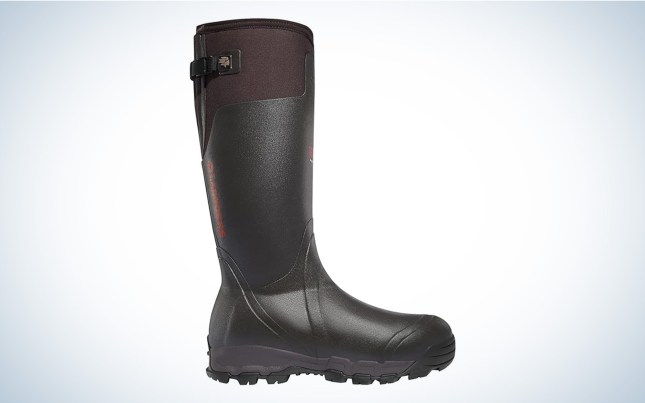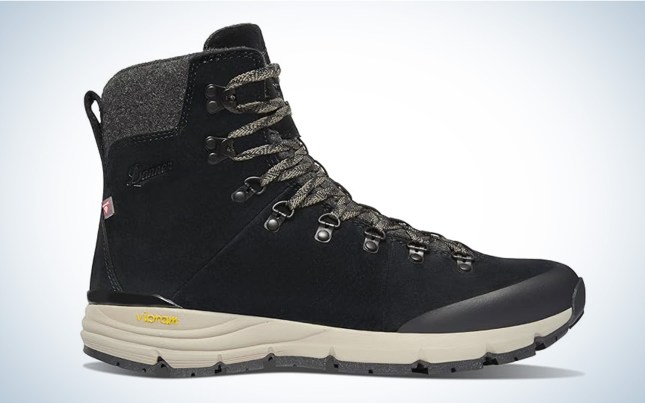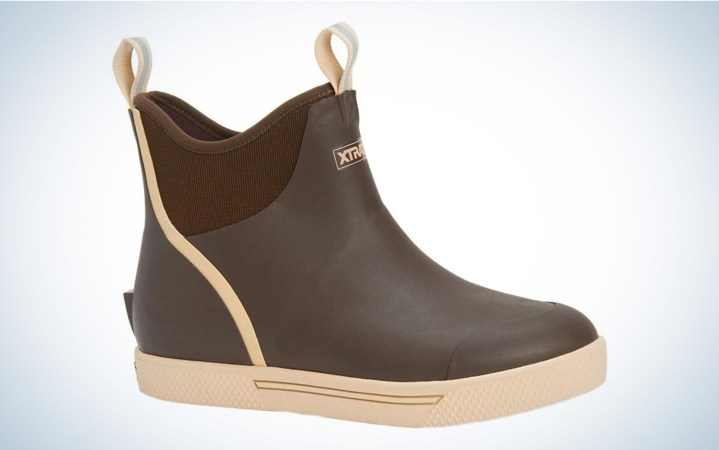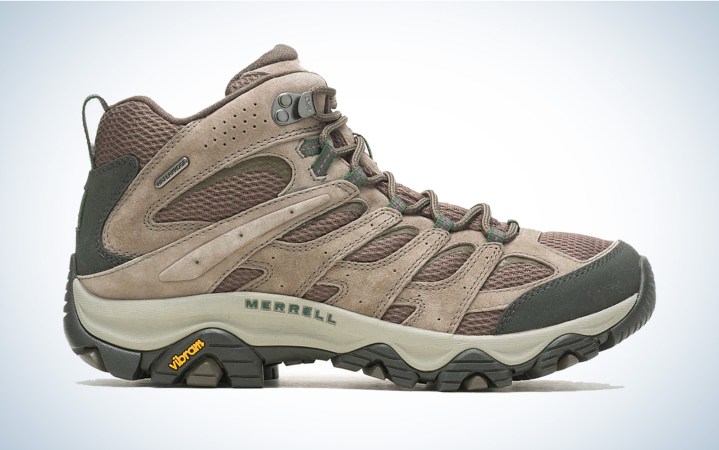We may earn revenue from the products available on this page and participate in affiliate programs. Learn More ›
Dry feet are happy feet. This mantra is something I remind myself, my hiking clients, and friends and family constantly. If there is anything I’ve done really well over my 7,000+ miles of hiking, it’s taking care of my feet. Maintaining moisture management through every activity is extremely important, so if I’m out backpacking for multiple days through wet terrain, I ensure I have a way to dry out my feet each night. The logical way to prevent wet feet is to wear weatherproof shoes for whatever activity you are partaking in. I narrowed down a list of the best men’s waterproof boots for hiking, fishing, and hunting in cold temperatures.
- Best Overall: BOGS Workman Boot
- Best for Extreme Cold: Lacrosse Alphaburly Pro
- Best Ankle: XtraTuf Wheelhouse
- Best All Rubber: Kamik Men’s Ranger Rubber Boots
- Easiest to Put On: Bogs Bozeman Tall Yulex
- Best for Winter Hiking: Danner Arctic 600 Side Zip
- Best Budget Hiking Boot: Merrell Moab 3 Mid WP
How I Chose the Best Men’s Waterproof Boots
Because I live in Alaska, I am constantly battling wet and cold weather through all the seasons. Even when it’s not raining, most of our alpine tundra is spongy and produces moisture with every step. I’ve tried out several men’s waterproof boots over the years and have strong opinions on my tried-and-true choices. Some options are newer to me, and I relied on Outdoor Life experts’ recommendations to field test.
The best way to test boots is to get out there and use them. Initially, I evaluate them for overall comfort on varying terrain, how easy they are to put on and take off, and, if applicable, the lacing system. For this specific test, I crossed lots of streams and rivers, and sometimes simply stood in the water to test the true waterproof ability of the boot. I also noted how the different outsoles and treads performed when traversing various surfaces, especially when slick from snow, ice, or water.
Best Men’s Waterproof Hiking Boots: Reviews & Recommendations
Best Overall: Bogs Workman Boot
Key Features
- Available Sizes: 7-15
- Regular options
- Weight: 4.35 pounds (pair)
- Price: $180
Pros
- Insulated
- 17 inches tall
- Ankle support
- 5mm Neo-Tech waterproof insulation
- Durable
Cons
- Neoprene outer top section can snag
Longevity and durability have a lot of clout when it comes to footwear. And since these boots have been my go-to pair for the last three years in all types of Alaska weather, they are hard to beat.
Besides keeping my feet warm and dry even when the outside temps dip to -30 degrees Fahrenheit, there are also few bonus features I appreciate. The slip-resistant outsole with its multidirectional lug pattern keeps me from falling on icy terrain. I like that when I put them on my heel locks into place, providing lower ankle support. The Bogs Workman boots have a raised notch on the back heel that allows you to kick the boot off with other boot, which is helpful since these are poised at my front door ready for my daily — and sometimes hurried — trips to the outhouse.
The upper neoprene portion of the boot is flexible, so I can easily tuck my pants into the boot or pull my pants over them. The boots even have DuraFresh technology that fights odors, so even after years of use these boots never have a bad smell. My only gripe it that some of the upper neoprene material has some pulls in it from catching on the thick Alaskan brush while walking off trail.
Best for Extreme Cold: Lacrosse Alphaburly Pro
Key Features
- Available Sizes: 6-15
- Regular options
- Weight: 5.5 pounds (pair)
- Price: $230
Pros
- Insulated
- 18 inches tall
- Durable
- Solid and camouflage color options
Cons
- Expensive
- Heavy
I upgraded to these burly boots a few years ago to make sure I was prepared for the extreme winter seasons in Alaska. They are marketed for temps as low as -70 degrees Fahrenheit, and they are ready for it. In early March, I volunteer as trail crew for the Iditarod Sled Dog Race each year, which means I am outside working in remote Alaskan villages in arctic temps for hours at a time. I have worn these outside working with one pair of merino wool socks in temps dipping below -40, and can attest to the warmth and comfort.
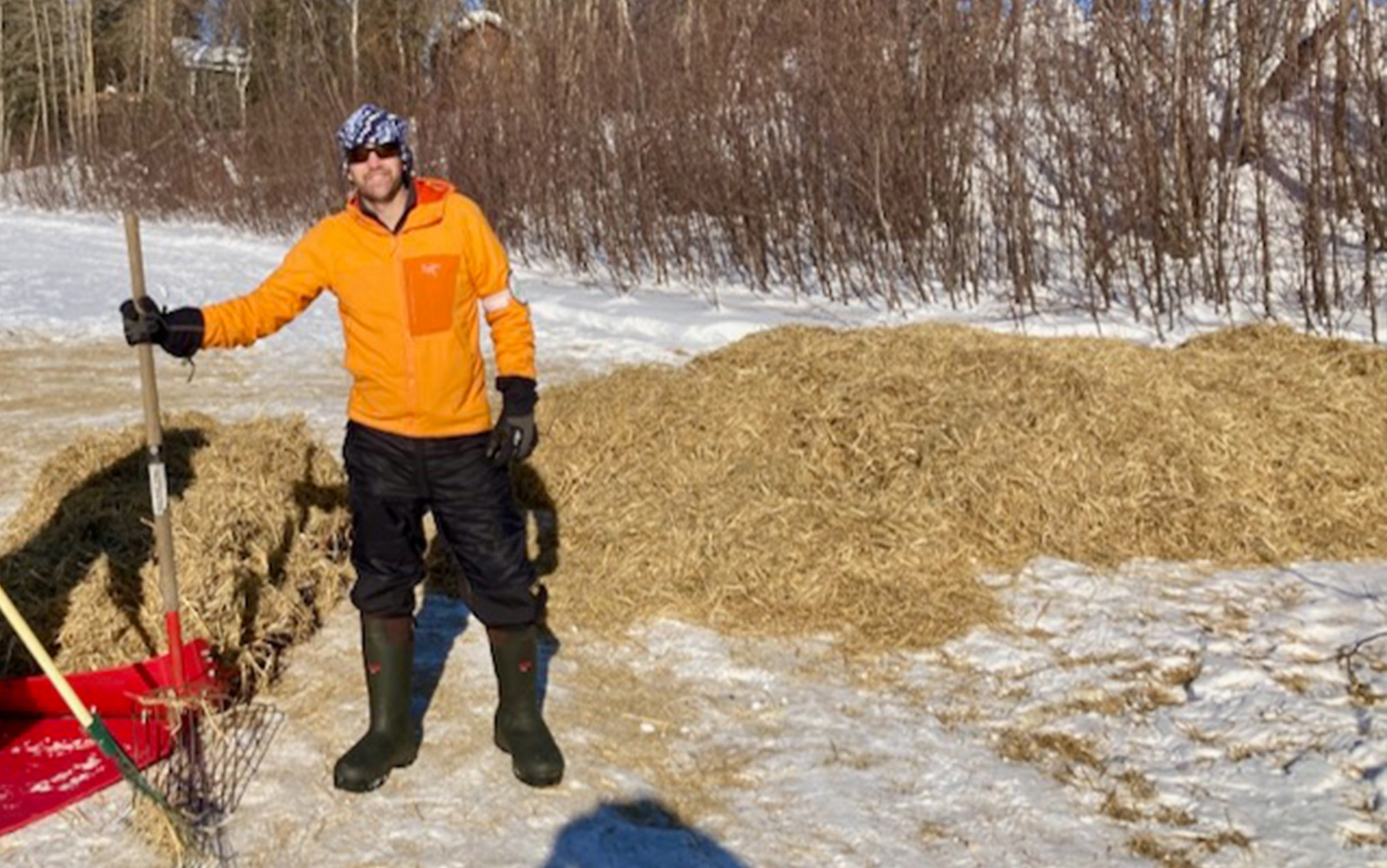
Justin La Vigne
I love that they are 18 inches tall and climb almost up to my knee. The outer layer is a thick, scent-free, rubber, and paired with the insulating 3.5mm neoprene core, these men’s waterproof boots provide rigid protection and ultimate waterproofing. On the top back of the boot there is a gusset that allows you to tighten the shaft securely around your upper leg. I have walked through feet of snow and with this secured system, and no snow gets inside like open-top boots.
Best Ankle: XtraTuf Wheelhouse
Key Features
- Available Sizes: 7-14
- Regular options
- Weight: 3.2 pounds (pair)
- Price: $135
Pros
- Easy on, easy off
- Simple design
- Durable
- Affordable
Cons
- Low cuff
- Run a bit wide
XtraTuf is synonymous with Alaska, as most residents own some variety of the brand’s waterproof neoprene boots, especially those in the fishing industry. The benefit of the Wheelhouse is that they are low cut — only reaching the ankle — and slip on and off in a second. The raised tab on the back of the boot allows you to kick them off, while dual loops (front and back) make the pulling on process a cinch.
Not only is the boot’s dual density insole comfortable, but it features built-in channels to help keep your feet cool and dry. The outsole has slip resistant properties with multidirectional lugs that do not leave marks on surfaces.
Best All Rubber: Kamik Men’s Ranger Rubber Boots
Key Features
- Available Sizes: 7-12
- Regular options
- Weight: 4.4 pounds (pair)
- Price: $50
Pros
- 100 percent rubber construction
- 12 inches tall
- Affordable
Cons
- Not a lot of support
The Kamik Ranger’s simple design and rubber construction are reminiscent of the boots your grandfather wore. These 100 percent rubber men’s waterproof boots are still one of the best available. What I love most about these is after getting them caked with mud I can simply rinse them off and they dry out quickly.
These boots are made for the wettest of weather and standing water, particularly when fishing or stomping around in puddles. They have an elevated heel and extra traction but are not supportive for long walks. Although many other brands make similar boots (i.e., Lacrosse, Bogs, and Muck), the Kamik bargain price is unbeatable.
Easiest to Put On: Bogs Bozeman Tall Yulex
Key Features
- Available Sizes: 6-15
- Regular and wide options
- Weight: 4.5 pounds (pair)
- Price: $165
Pros
- 15 inches tall
- Durable
- Comfortable
- Sustainable
Cons
- Neoprene outer top section can snag
These boots are very similar to the BOGS Workman boot but have a signature characteristic that I have grown to love. Two open handles on top of either side of the boots make them incredibly easy to pull on. And they still have the notch on the back of the boots to kick them off like the Workman Boot. The Bozeman Yulex have a heel lock fit where you can feel your heel stabilized inside.
A standout detail is the rubber material called Yulex, which is a more sustainable rubber harvested in Forest Stewardship Council approved regions. This rubber is said to improve its quality over time and get stronger rather than breaking down. I have only owned these for a couple of months and can say they have the same quality as day one, but I am curious to see if they don’t break down over the years.
Best for Winter Hiking: Danner Arctic 600 Side Zip
Key Features
- Available Sizes: 7-14
- Regular and wide options
- Weight: 2.8 pounds (pair)
- Price: $240
Pros
- Suede outer
- Insulated
- Winter traction
- Four color options
Cons
- Expensive
- Outsole could mark indoor surfaces
For winter hiking or snowshoeing, these have been my choice pair. The multidirectional Vibram Arctic grip outsole kept me grounded on icy and snowy hikes around Denali National Park. Thanks to the upper wrapped in 200 grams of Primaloft insulation, these provided me great warmth, even when temps dipped into -20 degrees Fahrenheit. They are tall hiking boots with a 7-inch cuff that hugs your ankles with six closed metal lace loops and two open lace hooks for upmost support. Plus, the cushy EVA middle and three-layered footbed is very comfortable.

Justin La Vigne
The inside upper portion of the boot has a waterproof zipper that you can use to get in and out of the boot. It does make it easier to get your foot out, but I really didn’t think it was a game changer. I believe the boot would perform just the same without the zipper.
Bonus: The suede upper makes them very stylish.
Best Budget Hiking Boot: Merrell Moab 3 Mid WP
Key Features
- Available Sizes: 7-15
- Regular and wide options
- Weight: 1.7 pounds (pair)
- Price: $150
Pros
- Affordable
- Durable
- Vibram outsole
- Proprietary waterproof membrane
- Can add Gore-Tex lining for additional cost
Cons
- Only mid-ankle cut available
- Mesh sections of boots can snag
This boot was featured in the Best Hiking Boots for Men, and the waterproof option deserves a nod as well. Merrell has been a fan favorite since 2007, but the options have come a long way from the original model. An enhanced footbed, arch support, and heel reinforcement elevates their comfort levels, but the brand is also using more eco-friendly materials. I have hiked more than 2,000 miles in all three versions of the Moabs, and love all those features, plus the grippy Vibram outsole.
Read Next: Best Hiking Boots for Men, Tested and Reviewed
Things to Consider Before Buying the Best Men’s Waterproof Boots

Justin La Vigne
Manufacturer
Some boot companies have a reputation of being the frontrunner in their respected industry, like Lacrosse founded in 1891 or XtraTuf founded in the 1950s. Most of the time, it is the word on the street — or the trail— that warrants the reputation of quality.
Read Next: Best Hiking Boot Brands
Waterproofing
If you’ll be standing in water, scrutinize the label to make sure the boots are 100 percent waterproof. Look for seamed sealing and boots that have an internal membrane made of a synthetic material like Gore-Tex to keep the moisture out. Outer layers constructed of rubber or leather also help.
Traction
If you are hiking, you need a boot that has good traction and support, like the Danner Arctic 600 Side Zip or the Merrell Moab 3 Mid WP. If you are in areas known for foul weather or crossing rivers, having waterproof boots can be a game-changer. Grippy outsoles are very important and can assist in traversing mud, dirt, rocks, ice, and snow.
Usually, every outsole looks different. The shape, size, direction, and depth of the lugs are what assist in traversing mud, dirt, rocks, ice, and snow. Vibram is the most common material type, but there were a few different compositions in this test.
Insoles
Most boots are made with an EVA foam insole. It is a soft material that absorbs some of the impact of your step. It sounds great in theory, but most of that foam is very thin and actually absorbs very little impact. Most factory insoles are thin and tend to break down quickly, get dirty, and start to smell. In most cases, I upgrade my insoles with an aftermarket brand, like Superfeet. These insoles are made to better cushion and cradle your feet with zone-specific areas that offer superior support and comfort.
Read Next: Best Insoles for Hiking
FAQs
Scrutinize the label to make sure it says 100 percent waterproof. Some boots may just have a waterproof lower, but the upper may not be waterproof. If the shoes are completely rubber like the Kamik Men’s Ranger Rubber Boots, then they are waterproof. Words like Gore-Tex and neoprene also indicate waterproofing.
That totally depends on your needs. If you are hiking, you need a boot that has good traction and support, like the Danner Arctic 600 Side Zip or the Merrell Moab 3 Mid WP. If you are simply out on a boat or standing in water while fishing, you don’t necessarily need traction for changing terrain, but do need completely waterproof boots, like the Kamik Men’s Ranger Rubber Boots or the XtraTuf Wheelhouse.
After each use, it is best to wash off your boots and let them air dry. Removing dirt and debris from the boot will prolong the life. Also, inspect your boots for holes or tears. You can find repair kits to bring them back to life. You may also need to reseal some boots to maintain the waterproof features.
Read Next: Best Waterproof Hiking Boots, Tested and Reviewed
Final Thoughts
I am a stickler for keeping my feet dry because I never know when wet boots will dry out. Nothing is worse than waking up in the morning and stepping out of your tent into wet, soggy, cold boots. I am a waterproof fanatic. Whether it is a day hike, multiday backpacking trip, fly fishing, boating, shoveling snow, or stomping around in puddles, I will only pull on a pair of boots that can keep me dry. The above selections all have a place in my boot rotation and will stay that way forever.
- Best Overall: BOGS Workman Boot
- Best for Extreme Cold: Lacrosse Alphaburly Pro
- Best Ankle: XtraTuf Wheelhouse
- Best All Rubber: Kamik Men’s Ranger Rubber Boots
- Easiest to Put On: Bogs Bozeman Tall Yulex
- Best for Winter Hiking: Danner Arctic 600 Side Zip
- Best Budget Hiking Boot: Merrell Moab 3 Mid WP
